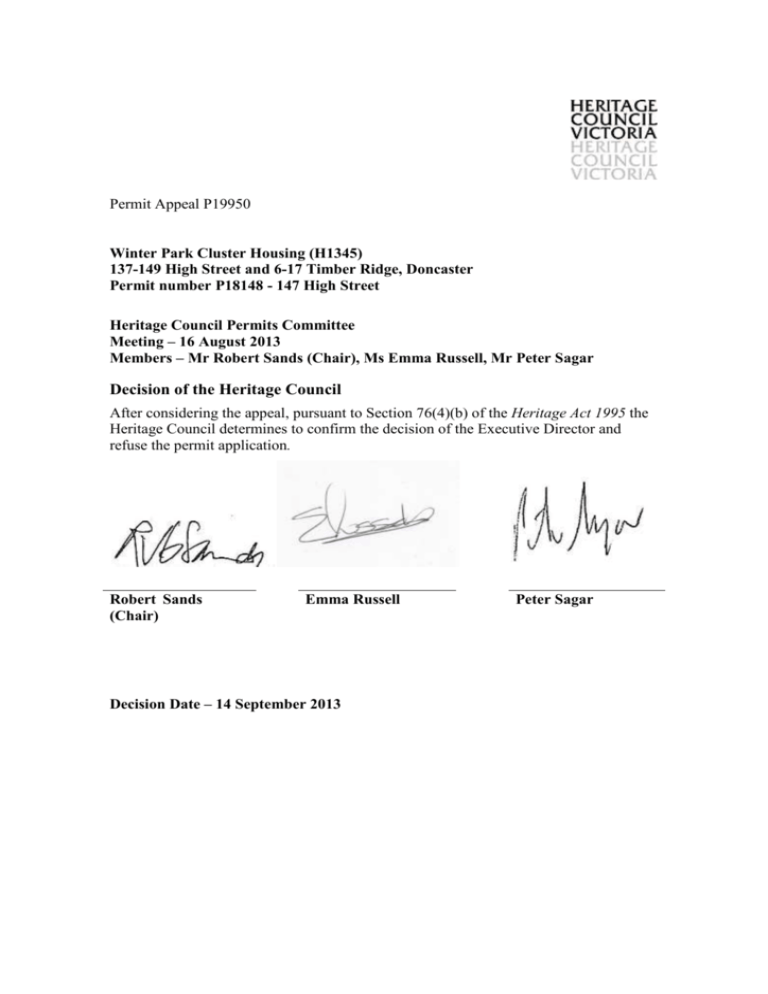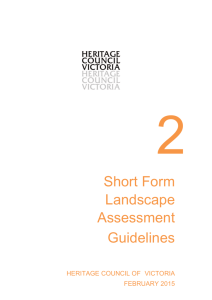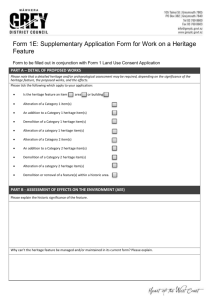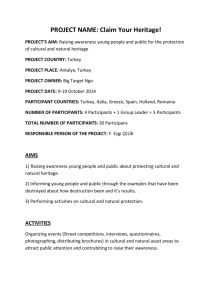147 High Street decision report
advertisement

Permit Appeal P19950 Winter Park Cluster Housing (H1345) 137-149 High Street and 6-17 Timber Ridge, Doncaster Permit number P18148 - 147 High Street Heritage Council Permits Committee Meeting – 16 August 2013 Members – Mr Robert Sands (Chair), Ms Emma Russell, Mr Peter Sagar Decision of the Heritage Council After considering the appeal, pursuant to Section 76(4)(b) of the Heritage Act 1995 the Heritage Council determines to confirm the decision of the Executive Director and refuse the permit application. Robert Sands (Chair) Emma Russell Decision Date – 14 September 2013 Peter Sagar SUBMISSIONS 1 2 The Committee received written submissions from the following parties: Executive Director, Heritage Victoria; Manningham City Council; and Mr Gerald and Mr Bernice Lane, owners of 149 High Street. In addition to the permit application documents, the Committee also considered submissions about the permit application made to the Executive Director pursuant to s.69 of the Heritage Act 1995 (‘the Heritage Act’) from: Mr and Mrs Lane; Ms Randi Kerr; and E J Qualtrough. INTRODUCTION/BACKGROUND The Place 3 Winter Park Cluster Housing (‘Winter Park’) comprises twenty detached houses on a 2.43 hectare site, constructed in stages between 1970 and 1974. Four groups of five houses are located around communal car and pedestrian access ways. Each dwelling has a private garden and courtyard in addition to a large central communal recreation space. 4 The place was included in the Victorian Heritage Register as H1345 in November 1997. 5 The application for Permit number P18148 relates to number 147 High Street, one of the twenty houses making up Winter Park. The Applicant 6 On 14 December 2011, the owner of 147 High Street, Mr Michael McDonald, applied for Permit number P18148 for a single storey extension in the courtyard and pergola-covered walkway on the east side of his property. The application included a Heritage Impact Statement (‘Impact Statement’) prepared by Mr David Bick, Architectural Historian and Conservation Architect. Determination of the Executive Director 7 On 12 March 2013, the Executive Director determined to refuse to the permit application pursuant to s.74(1)(c) of the Heritage Act. The reasons for the refusal were as follows: The proposed addition is considered intrusive to the identified cultural heritage significance of the Winter Park Cluster Housing as a whole. The permit policy for the place states that the Winter Park Cluster Housing is significant for its layout and landscaping and for the relationship of the individual buildings to the cluster rather than their individual qualities, particularly their interiors. The proposed addition will result in an 2 September 2013 unacceptable change to the layout by infilling the courtyard and building to the boundary lines. Site Inspection 8 The Permits Committee made a site inspection accompanied by the Hearings Officer on 13 August 2013. The Applicant and Ms Janet Sullivan, Permits Manager, Heritage Victoria were present. The Committee did not receive any verbal or written submissions during the inspection. Preliminary Matters 9 The permit application documents were circulated to all parties; however, no further submissions were received from the Applicant. With the consent of the Applicant, the Committee resolved to determine the matter without a hearing pursuant to s.76(2)(b) of the Heritage Act. ISSUES 10 This section is not intended to be a complete record of submissions that were made to the Committee. It is a summary of what the Committee considers to be the key issues, followed by an explanation of the position the Committee takes on each issue. Summary of issues 11 The Committee had regard to the matters to be considered in determining permit applications listed at s.73 of the Heritage Act (see Attachment 1 to this report). 12 The Committee has addressed the most pertinent matters at length, being the impacts upon the cultural heritage significance of Winter Park, including the impacts on the amenity of 149 High Street, (s.73(1)(a)); and the reasonable use of the registered place (s.73(1)(b)). Mandatory considerations s.73(1)(a) the extent to which the application, if approved, would affect the cultural heritage significance of the registered place 13 The Committee received submissions about the impact of the proposal on the cultural heritage significance of Winter Park. 14 The statement of significance for the place is as follows. What is significant? The Winter Park cluster subdivision, comprising twenty detached houses on a 2.43 hectare (six acre) site, was designed by architect Graeme Gunn together with Merchant Designs (architect Rob White) for the firm Merchant Builders Pty Ltd which constructed the development in stages between 1970 and 1974. The four groups of five houses are located around communal car and pedestrian access ways, and each dwelling has a private garden in addition to a large central communal recreation space. The central idea was the free siting of houses, private garden and communal open space to achieve an integration of 3 September 2013 the built environment within the most efficient use of land. The landscaping for the whole development was designed by Ellis Stones (1895-1975). How is it significant? Winter Park is of architectural, social, historic and aesthetic importance to the State of Victoria. Why is it significant? Winter Park is architecturally and socially important as the prototype cluster housing development project in Australia - an experimental attempt to present an alternative to the existing subdivision pattern of the "quarter acre block". Winter Park and its protagonists were influential in encouraging the Victorian Government to introduce the Cluster Titles Act 1974, supported by a Model Cluster Code, to control future cluster housing subdivisions and eventually to consolidate all subdivision legislation in a single act. In 1975 the Winter Park development received a citation in the Royal Australian Institute of Architect's Housing Awards. Winter Park is historically and socially important for its association with Merchant Builders Pty Ltd, one of the most influential building companies in Victoria in the post-war era. Merchant Builders, which flourished during the 1960s and 1970s, pioneered the introduction of energy efficient, environmentally friendly, architect designed project homes in Victoria. Some of the many innovative design principles and features they pursued included pergolas, exposed brickwork and timber beams, passive solar energy and the use of indigenous materials. Winter Park is also historically important for its association with John Ridge and David Yencken, Directors of Merchant Builders, Graeme Gunn architect, and Ellis Stones, landscape designer. Graeme Gunn was one of Victoria's leading architects over three decades. Together with John Ridge and David Yencken they pioneered the introduction of contemporary architect-designed project housing in the 1960s. Graeme Gunn received many awards for his architectural designs. Ellis Stones, together with Edna Walling (1898-1973), was an important pioneer of contemporary garden design in Victoria, if not Australia. Stones and Walling are said to have kept alive the tradition of Australian landscape architecture. Stones' style of landscaping was characterised by a complete assimilation and mastery of Australian native materials and an authentic Australian character and Winter Park is considered to be one of his finest works. Winter Park is of aesthetic significance for its outstanding landscape and architectural design qualities where low profile buildings (having recycled bricks and stained timber joinery) and red brick paving, tea-tree fences and recycled brick walls are integrated into the grassy woodland including indigenous trees (in particular, Eucalyptus cephalocarpa). The aesthetic significance also derives from the central parkland planting, and the naturalistic landscape design using rocks, timber edges and seats, and planting of predominantly Australian natives. Submissions and evidence 15 As outlined in the reasons for refusal above, the Executive Director’s view was that the proposal conflicted with the identified heritage values of the place. 16 The Executive Director submitted that the Applicant had provided inadequate justification for the impacts of the proposal on the significance of the place, 4 September 2013 particularly its landscape and architectural design qualities. The Executive Director drew the Committee’s attention to the permit policy for the place, which states that ‘the Winter Park cluster housing is significant for its layout and landscaping and for the relationship of the individual buildings to the cluster rather than their individual qualities, particularly their interiors’. It was noted that each house is free-standing in a landscaped setting and not built to any boundary. 17 Ultimately, the Executive Director’s view was that the proposal to build-in part of the pergola-covered entrance area and the courtyard up to the boundary line on two sides would be an unacceptable compromise of the identified significance. 18 Manningham City Council submitted that its heritage advisor, Ms Willys Keeble, supported the decision of the Executive Director. In Ms Keeble’s view, the proposed building in the back courtyard at 147 High Street would disrupt the significant layout and landscape values of the Winter Park cluster housing complex. She also provided the following notes: The orientation, arrangement and disposition of private open space in the Winter Park cluster housing complex is of primary heritage significance. It was carefully designed to achieve a very high level of amenity, including winter sun and connection to the outdoors. Every dwelling in the complex has two areas of private open space: one on the east and one on the west side. Living rooms, dining rooms and family rooms face onto large garden courtyards which in turn abut the Winter Park communal gardens. Bathrooms, laundries and bedrooms generally face onto smaller service courtyards which abut the service courtyard of the adjoining house. The smaller courtyard is sunny when the larger courtyard is not. The sense of space, privacy and amount of sun in the service courtyards is maximised by the abutting open space in the adjacent property. 19 Ms Keeble also argued that the proposed works would harm the design integrity of 147 and 149 High Street. She noted that 147 would lose its access to outdoor winter morning sun and its clothes drying area; and the back courtyard of 149 would lose its sense of space and be overshadowed during winter afternoons by the new building. 20 Manningham City Council also submitted that the original layout and design of the place is important and that its cultural significance depends upon the design integrity of each unit of housing, its garaging and internal courtyards remaining intact. The Council argued that the proposed addition is unsympathetic and unnecessary and that the removal of the original entrance verandah and pergola would be a loss to integrity. 21 Mr and Mrs Lane (‘the Lanes’) submitted that the proposed extensions will constitute a significant departure from the original design features of Winter Park. They argued that a significant aspect of the design of the place was dwellings being sited in such a way as to maximise the opportunity for individual residents to enjoy open spaces, courtyards and landscaping. According to the Lanes, it is significant that no part of a dwelling abuts an 5 September 2013 adjoining property boundary. They argued that the designers’ policy was that a courtyards were not encroached upon by a neighbouring dwelling. 22 The Lanes also submitted that the five trees proposed to be removed are part of the significant Ellis Stones design (see Statement of Significance above). 23 The Applicant submitted that the proposed extension is small in size and has been located to result in the minimum degree of change to Winter Park. He argued that the addition will be concealed when viewed from almost all aspects of the adjacent central common courtyard and will be fully concealed from the remainder of the complex, therefore the impact on significance will be minimal. 24 Mr Bick in his Impact Statement argued that the only expected detrimental impact will be that as an alteration is being made to the original design, the intactness of the place will be reduced by a small amount. In his view, this small addition is not unreasonable and could be reversed in the future. He noted that the area proposed to be built on was always intended to be a ‘service area’ not a principal outdoor area. 25 Mr Bick also held that the development will be largely concealed. According to him, the exterior of the proposed addition will be in harmony with the existing house by being of a similar appearance but not exactly replicating the original, in accordance with Burra Charter principles. Impacts on 149 High Street 26 The Committee received submissions about the impact of the proposal on the amenity of 149 High Street, also part of the registered place. 27 The Lanes submitted that the proposed works will have a detrimental impact on the outlook from the adjoining property at 149 High Street and will cause a loss of amenity, especially in relation to the use of the rear courtyard. The rear courtyard of 149 abuts the rear courtyard of 147 – the location of the proposed extension. The Lanes submitted that the proposed extension would effectively enclose the courtyard of 149 on three sides, where it was previously not enclosed at all. In the Lanes’ view, this would constitute a serious loss of amenity to the courtyard and other areas of 149 and would be a significant departure from the original design of Winter Park, which aimed to maximise the opportunity for individual residents to enjoy open spaces, courtyards and landscaping through shared aspect, light and landscape 28 The Lanes submitted that the trees that are proposed to be removed shade the rear courtyard of 149 from the northern sun. 29 The Applicant submitted that the proposed addition will have a relatively low visual impact on 149 due to its floor level being around one metre lower. It was also argued that extensive vegetation on the common boundary will screen the proposed addition. Mr Bick’s Impact Statement did not consider the impacts of the proposal on 149 High Street. Discussion and conclusion 30 In the Committee’s view, the proposed development will have a detrimental impact on the cultural heritage significance of the place. The proposed development will result in a loss of the design intent, which at present is readily appreciated. 6 September 2013 31 The Committee notes that the Permit Policy for the place states that it is ‘significant for its layout and landscaping and for the relationship of the individual buildings to the cluster rather than their individual qualities, particularly their interiors’. 32 In the Committee’s view, the layout of dwellings and open space is a significant aspect of the place. The way that each property interacts – allowing private space, interaction of light and trees, and the benefit of shared open space is also considered to be significant. Each property has ‘respect’ for adjoining properties and the design encourages a culture of sharing. The front porch and entry area is a strong and consistent element throughout the place. Changing this in the manner proposed is considered to be detrimental to the significance of the place. 33 The Committee finds that the form and size of the proposed addition is inappropriate. The hipped roof form, being foreign to the design ethic, is considered to be unsympathetic and the overall size too large. 34 The Committee notes Mr Bick’s claim that the development would largely be concealed. However, a factor that he did not take into account is that most of the tree canopy will be removed as part of the works as most of the taller trees are in the subject area. These trees are part of the visible landscape for both 147 and 149 as well as the shared driveway/entry area. The extension would be predominantly visible from the other parts of the site, if not from the subject unit. The Committee agreed that even if the addition were largely concealed, this would not necessarily reduce the impacts upon significance. 35 In a cluster development such as this, with recognised and valued significance, it is not a given that individual units can be increased in size. The effects of such changes on the other units must be taken into account. The Committee considers that the proposed works will have a detrimental impact on the aspect of and availability of light and shade to 149 High Street, and hence an impact on the significance of that part of the place. 36 The Committee notes and agrees with the submission of Mr McDonald that ‘the purpose of the Victorian Heritage Register listing of H1345 is to regulate all works to ensure the appropriate conservation of the heritage place. Change – alterations and additions, are not prohibited – rather the test is, will they adversely affect the cultural significance of the heritage place’. In the Committee’s view, the proposed extension in the rear courtyard of 147 High Street would have an unacceptable impact on the identified significance of the place. s.73(1)(b) the extent to which the application, if refused, would affect the reasonable or economic use of the registered place or registered object, or cause undue financial hardship to the owner in relation to that place or object 37 The Committee received submissions on the effect on reasonable use of the place if the permit is refused. Submissions and evidence 38 147 High Street currently has three bedrooms, two bathrooms and two living areas. In the Executive Director’s view, the refusal of the application means the place is still able to be reasonably used, as it provides facilities commensurate with modern living standards. 7 September 2013 39 The applicant argued that he requires an additional bedroom so that each of his three daughters can have a room of their own. Discussion and conclusion 40 The Committee has had regard to the Heritage Victoria and Heritage Council of Victoria Policy Guideline ‘Matters to be considered in determining a permit application under section 73(1)(B) of the Heritage Act 1995’. 41 147 High Street is currently used as a dwelling. The permit application does not propose a change to the use of the place. If the application is refused, the Committee agrees with the Executive Director that the property will still be able to be reasonably used as a dwelling as it provides facilities commensurate with modern living standards. ‘Reasonable use’ is not about an applicant’s personal circumstances. s.73(1)(c) any submissions made under s.69 42 The Committee considered three submissions that were made under s.69 (listed above under the heading ‘Submissions’). The content of these submissions has been addressed under the relevant headings in this report. Discretionary considerations s.73(1A)(b) any other relevant matter 43 Concern was aired in a number of submissions that a precedent may be set if this permit is granted. The Committee did not take these concerns into account in reaching its decision. Each permit application or appeal is considered on its own merits. After considering the matters set out at s.73 of the Heritage Act, the Committee was of the view the Executive Director’s decision should be upheld. CONCLUSION 44 After considering the appeal and conducting a hearing, pursuant to Section 76(4)(b) of the Heritage Act 1995 the Heritage Council determines to confirm the decision of the Executive Director and refuse the permit application. 45 The Committee found that the proposed works would have an unreasonably detrimental impact upon the cultural heritage significance of the place and upon the amenity of adjoining properties within the place. The Committee was not convinced that the reasonable use of the place would be affected by refusal of the permit application. 50 It is recommended that a Conservation Management Plan for the place be prepared to assist with future changes proposed to individual dwellings and shared areas. 8 September 2013 ATTACHMENT 1 73. Matters to be considered in determining applications (1) In determining an application for a permit, the Executive Director must consider(a) the extent to which the application, if approved, would affect the cultural heritage significance of the registered place or registered object; and (ab) if the application relates to a listed place or to a registered place or registered object in a World Heritage Environs Area, the extent to which the application, if approved, would affect (i) the world heritage values of the listed place; or (ii) any relevant Approved World Heritage Strategy Plan; and (1A) (b) the extent to which the application, if refused, would affect the reasonable or economic use of the registered place or registered object, or cause undue financial hardship to the owner in relation to that place or object; and (c) any submissions made under section 69; and (d) any decision of the Heritage Council under section 72 which has been received; and (e) if the applicant is a public authority, the extent to which the application, if refused, would unreasonably detrimentally affect the ability of the public authority to carry out a statutory duty specified in the application; and (f) any matters relating to the protection and conservation of the place or object that the Executive Director considers relevant. In determining an application for a permit, the Executive Director may consider(a) the extent to which the application, if approved, would affect the cultural heritage significance of any adjacent or neighbouring property that is (i) subject to a heritage requirement or control in the relevant planning scheme; or (ii) included in the Heritage Register; and (b) any other relevant matter. 9 September 2013








